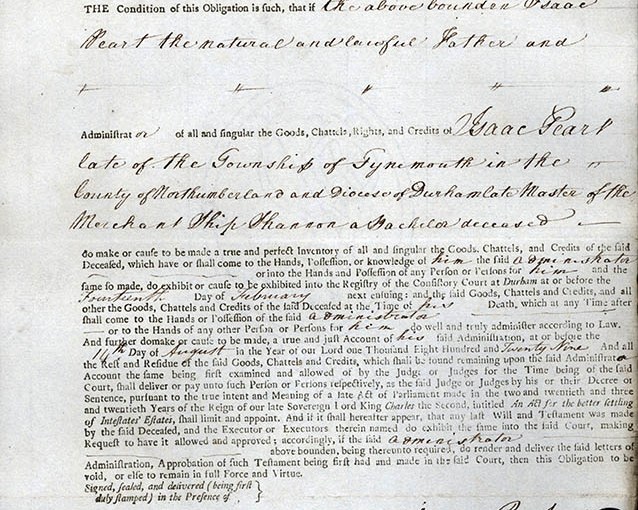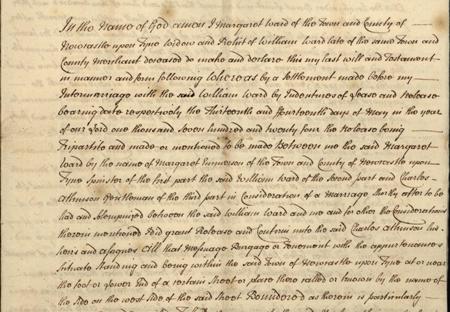Will bonds and Administration bonds

Before the Durham probate court would grant probate or administration to the personal representatives of the deceased, the executors or administrators would be required to enter into a bond with the bishop. Guardians of minors would also be required to do so prior to obtaining grants of tuition or curation. The purpose of these bonds was to bind the bondsman to perform a set of defined actions at or before certain dates, and in this way to ensure the testator's will was fully executed or that the intestate's estate was properly administered. Should these actions fail to occur, the bondsman became liable to a penalty, the penal sum of the bond, usually twice the value of the deceased's estate.
Such bonds thus protect the interests of creditors, legatees and the next of kin of the deceased. They were also a means of indemnifying the bishop and his officials from the consequences of any default or maladministration of the deceased's estate on the part of the executors or administrators. Curiously, the ecclesiastical jurisdiction being a spiritual one, the probate court had no power to enforce the financial penalty should a bondsman fail in any of the conditions of the bond. In such cases, and upon sufficient proof, the bond could be delivered out of the registry to an interested party so that an action in the bishop's name might be brought in the temporal courts. It is important to note, however, that executors and administrators were not personally liable for any bonds, contracts or debts entered into by the deceased during his lifetime: while such debts were always settled first, before payment of legacies or distribution to the next of kin could occur, they could only be settled in so far as the totality of the deceased's estate allowed.

The first section of the administration bond of Isaac Peart, master of the ship Shannon [Ref: DPRI/3/1828/A90].
The format of such bonds is invariably the same, being in two parts: the first part, until 1733 usually in Latin, stating the names of the bondsman and sureties, the penal sum and the date, and the second part a statement of the conditions. The sureties together agreed to underwrite the bondsman's liability, and thus each must have been sufficiently wealthy to cover half the penal sum. Sometimes affidavits of the sureties to this effect accompany the bond. At Durham, as generally elsewhere, the penal sums were calculated at double the value of the deceased's estate. Strictly speaking as the bond might be entered long before an inventory had been completed, the estimated value of the estate might have been only notional. However in practice executors and administrators usually moved quite quickly and already had a draft inventory of the deceased's estate ready by the time they were formally appointed as the personal representatives. The bond is then dated, so completing the notification.

The conditions section from the administration bond of Isaac Peart, master of the ship Shannon [Ref: DPRI/3/1828/A90].
Then follows the statement of conditions. For much of the period for which probate bonds survive at Durham, these bonds are written on small membranes of parchment, with the seals of the bondsman and sureties attached to tags.
![Click to zoom Image of the administration bond for the goods of Edward Thompson [Ref: DPRI/3/1589/B273].](images/DPRI-3-1589-B273.jpg)
The administration bond for the goods of Edward Thompson, with the signatures, marks and seals of the bondsman and sureties William Hubbock (the husband of the administratrix), Anthony Barrow and William Olliver. The staining at the head of the bond, the notification clause, was caused by the (now deprecated) application of tannin solution to aid legibility [Ref: DPRI/3/1589/B273].
Such parchment bonds carry the notification on the front or face of the document, and the conditions on the back or dorse. Among the Durham probate bonds, even before 1733 when legislation changed the official language of record in Britain from Latin to English, the conditional part of a bond was usually written in English. In the 17th century the Durham probate bonds began to be printed on paper, with the whole text carried on the face of the document.
The conditions required of the bondsman, or 'obligor', vary according to whether the person is to execute a will or distribute an intestate's estate. The sequence of certain common events however does not vary, in that each must exhibit in the court at or before certain dates first an inventory of the deceased's goods, and then some time later, upon the completion of their duties, a financial account. Together these two documents would demonstrate how many and of what kind the goods and debts of the deceased were, and, later, how these debts had been paid and the property delivered to the legatees or distributed among the next of kin. When both documents had been officially passed by the court and entered into the registry, the responsibilities of the bondsman were completed, and his liability extinguished. At this stage some bonds were removed from the registry, or, more commonly, cancelled, or the seals of the bondsman and sureties were removed from the bond itself.
The bonds of executors are termed will bonds, while administrators signed administration or 'admon' bonds. In many dioceses will bonds were only required from executors appointed by the court, either upon the renunciation or default in some other way (death, minority, disqualification) of the executors nominated by the testator in the will. This is true too at Durham in the later period, but before then will bonds signed by all types of executors can be found in the Durham bonds series, and probably in most other dioceses in the northern province. As stated, the conditions for each type of bond (will or admon) vary in detail, and aid in their identification.
An executor must,
An administrator must,
Early bonds will often simply state the names of the bondsmen and sureties, and further details about the grant might only be found perhaps among the recorded Acts of the court. Latterly, however, some personal details such as place of abode and status or occupation were entered on the bond, sometimes also providing a brief indication of how or why the executor or administrator was entitled to act, stating his or her relationship to the deceased for example.
[from a 1589 administration bond Ref: DPRI/3/1589/B273].
[from a 1853 administration bond Ref: DPRI/3/1853/A221]
Probate business can become complicated, protracted and much delayed, and as demonstrated in the above example such probate bonds, while following the standard form already described, can become much expanded. The key points are to determine firstly the identity of the bondsman and the nature of their interest in the deceased's property, a relative, or a creditor perhaps. Secondly, the bond may be for the entire estate or limited to only a part of it, to a child's portion or to the deceased's interest in a particular property, for example. Understanding these points can help clarify the stage reached in the probate process.
For example, a complex estate might take some years to fully administer, during which time the executor dies, requiring the replacement of that executor's will bond with an 'administration with the will annexed' bond, signed by the newly appointed administrator to whom a grant of administration with the will annexed is then made.
Limited bonds can occur more than a generation after the original probate, and are an indication that the original administration of the estate was not completed in some important but neglected detail. Latterly, perhaps, a property is intended to be sold, only for it to be discovered that its title is still vested in the unadministered estate of a long deceased former owner. In such cases a bond might be entered by persons now with an interest in that property and to whom the probate court grants a right to administer the estate, but which grant is strictly limited to the deceased's interest in that particular property alone. Such limited bonds can be useful sources, as they often summarise or recite parts of now lost deeds and settlements associated with that property and its owners in order that the bondsman's validity of title is established and entered into the court's record.

Sometimes marriage settlements can be recited in wills. In this case a widow of Newcastle named Margaret Ward (née Emmerson) exercises a right that was negotiated at her marriage eighteen years previously, that should she survive her husband she might raise £250 from a property in the Side that she had brought with her to the marriage, and which is to be paid upon her death to her son Charles Ward, clerk. The probate records of men are much more common than for women, and among women widows outnumber spinsters. Due to laws that prevailed until the Married Women's Property Act in 1882 married women had very limited property rights, and indeed could not make a will without their husband's consent, and which consent could still be revoked by a husband after his wife's death. [Ref: DPRI/1/1743/W7/1-2]
It will be appreciated then, that while bonds can be formulaic and rather dry, they can provide useful pointers for family historians.


